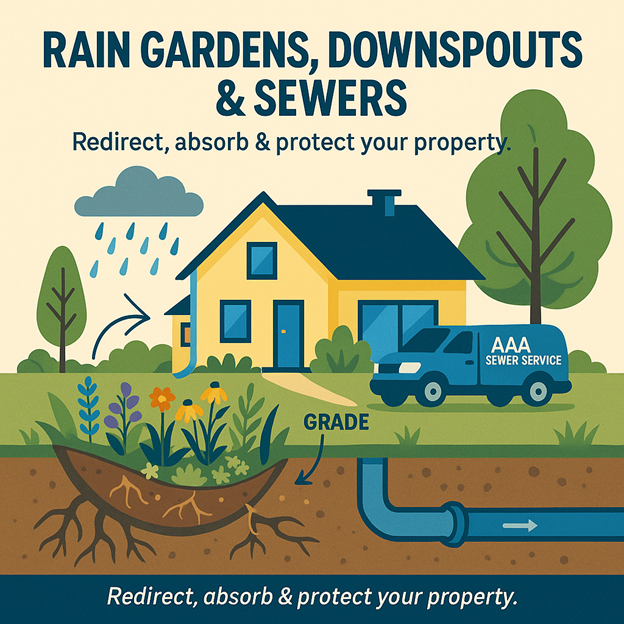When it comes to preventing sewer backups and managing stormwater in Fort Wayne, your yard isn’t just landscaping — it’s a powerful first line of defense. The way water flows through your property directly affects the stress placed on your sewer lateral, sump pump, and even city-wide systems. That’s why modern homeowners are turning to smarter outdoor infrastructure — like rain gardens, downspout redirection, eco-grading, and tree root barriers — to absorb stormwater before it overwhelms pipes or causes backups.
In this deeply expanded guide, we’ll explore how to transform your yard from a runoff risk into a sewer-safe system — all while boosting beauty, biodiversity, and property value.
1. Why Your Yard Matters to Your Sewer (More Than You Think)
Every storm in Fort Wayne tests the limits of residential drainage. With Indiana’s seasonal extremes — from summer cloudbursts to winter freeze-thaw — your yard’s water behavior becomes critical to:
- Preventing overwhelmed sewer lines during heavy rainfall
- Reducing sump pump workload by managing groundwater before it reaches foundation
- Avoiding pipe strain or collapse from shifting, waterlogged soil
- Protecting the sewer lateral from moisture-seeking tree roots
- Minimizing hydrostatic pressure against basement walls
Neglecting this relationship can lead to costly emergencies. But handled well, your yard can act as a storm buffer that absorbs runoff, filters pollutants, and gently guides water away from critical infrastructure.
2. What Is a Rain Garden (And How Does It Actually Help?)
A rain garden is a low-lying, bowl-shaped landscaped area planted with native species that love both wet and dry conditions. It captures runoff from roofs, driveways, and compacted lawns — holding it temporarily before slowly releasing it into the soil.
How it works:
- Captures runoff in a shallow basin
- Filters it through engineered soil
- Allows gradual infiltration instead of fast flow
Why it matters:
- Reduces volume of water entering Fort Wayne’s storm sewers
- Filters out chemicals, oils, and sediments before they enter waterways
- Prevents soggy lawn zones and protects slab foundations from subsurface saturation
Rain Garden Installation Tips:
- Excavation depth: 6–12 inches
- Soil mix: 50% sand, 30% compost, 20% topsoil
- Drain time: Should fully absorb water within 24–48 hours
- Don’t place over buried sewer or gas lines!
3. Rethinking Downspouts: Redirecting Water with Purpose
Your roof sheds thousands of gallons of water per year. If that water lands near your foundation — or worse, near your underground sewer line — you risk:
- Soil erosion and pooling
- Sewer lateral infiltration
- Freeze damage in winter
- Tree root attraction
Smart downspout strategies:
- Install downspout extenders at least 6 feet long
- Add splash pads or rock swales to slow flow
- Aim downspouts toward rain gardens, not driveways
- In colder months, disconnect or winterize flexible extensions to prevent freezing
For older Fort Wayne homes with combined sewer-storm systems, every gallon you keep on your property helps prevent municipal backups.
4. Grading & Drainage: The Hidden Force Behind Pipe Longevity
Many sewer issues begin not underground, but on the surface — in subtle slopes that funnel water toward your home or yard cleanouts.
Ideal yard grading includes:
- 5% slope (6-inch drop over first 10 feet)
- Positive drainage around all four sides of the house
- Use of berms (soil mounds) or swales (shallow ditches) to guide flow
Drainage solutions:
- French drains to intercept persistent wet spots
- Dry creek beds for aesthetic stormwater control
- Catch basins or pop-up emitters for fast-moving runoff
In Fort Wayne’s older neighborhoods, where clay soil dominates, correcting slope and drainage is especially vital to prevent standing water that compromises lateral integrity.
5. Tree Roots & Sewer Risk: Why Watering Patterns Matter
Roots grow where water is. If your yard has leaking hoses, over-irrigated beds, or poor grading near your lateral, roots will target those areas.
Root-proofing your sewer system:
- Plant trees at least 15–20 feet away from laterals
- Avoid high-water-demand trees like silver maples, willows, and poplars
- Use copper sulfate or root barriers near sewer paths
- Don’t create long-term wet zones above sewer lines
AAA Sewer Service has removed roots longer than 10 feet from lines in southeast Fort Wayne — almost always due to persistent moisture attracting growth.
6. Native Plants That Fight Flooding (And Look Great Doing It)
You don’t need to sacrifice beauty for performance. These Indiana natives offer drainage performance, seasonal color, and low maintenance:
Top Fort Wayne picks:
- Blue Flag Iris: Excellent for soggy beds near sump outlets
- Purple Coneflower: Butterfly magnet with deep roots
- Joe-Pye Weed: Tall, dramatic, perfect for back borders
- Switchgrass: Stabilizes slopes and absorbs lots of water
- Prairie Dropseed: Dense clumping grass for garden edges
Together, these species support pollinators, cleanse water, and reduce the need for synthetic fertilizers or irrigation.
7. How AAA Sewer Service Helps You Design for Drainage
AAA doesn’t just fix clogs — we help future-proof properties. Our camera inspections, yard drainage evaluations, and grading feedback identify risks before they become emergencies.
We can:
- Inspect lateral path proximity to water features
- Flag buried cleanouts too close to downspouts
- Recommend trenchless rerouting if rain gardens or slopes must cross pipe lines
- Offer seasonal evaluations after spring or fall storms
We’ve worked with dozens of Fort Wayne homeowners to integrate sewer-safe yard upgrades without disrupting landscape plans or budgets.
Final Word: Build a Smarter Yard. Defend Your Sewer. Protect Your Home.
Your landscape is more than aesthetic. It’s a frontline defense against flooded basements, broken sewer lines, and sump pump burnout. By thinking like water — and acting like a planner — you can make your yard beautiful, eco-friendly, and sewer-smart.
📞 Call AAA Sewer Service at (260) 456-6930
🌐 Visit our website: www.aaasewerservice.com

